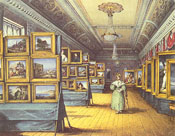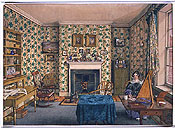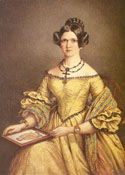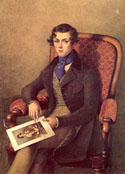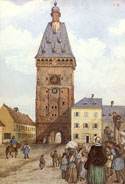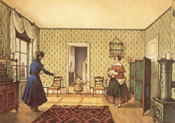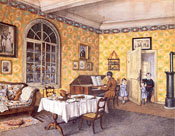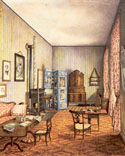The browser will either open the file, download it, or display a dialog.
|
|
Negotiating Identity: Mary Ellen Best and The Status of Female Victorian Artists |
|||||
|
At about age fifty, Mary Ellen Best (1809–1891), a middle-class British woman, gathered images of her private life that she had painted over a 35-year period and placed them into albums organized chronologically.1 Necessarily, this process would have been a selective one. Best would have chosen images that corresponded to her inner narrative of self—an intricate interweaving of societal expectations based on her class, race, and gender as well as her own mediation of such norms. Indeed, as Best's albums imply, subjectivity is hardly stable and cohesive; it is more often fractured and disjunctive, historically constructed in and through prescriptive discourses. Though individuals can assume conflicting subjectivities at various moments or even concurrently, Best's albums indicate that the simultaneous roles of middle-class housewife and female artist were not viable ones for her.2 If, as Abigail Solomon-Godeau suggests, we must attend carefully to the self-representations of nineteenth-century women, we do well to examine Best's construction of a visual autobiography for what it reveals about the difficult choices faced by middle-class female artists during the early years of the Victorian period.3 | |||||
| In the past decade and a half, the complex situation of professional and amateur women artists during the Victorian era has been studied in great detail.4 What has received less attention is the pictorial record of those artists, such as Best, who occupied a liminal position between professional and amateur, constantly negotiating their artistic ambitions and their middle-class status.5 These artists have usually been described as working in an amateur tradition, in that they limited their medium to watercolor and their subject matter to domestic scenes, nature, and still lifes. They include the countless number of women who kept albums, for example Maud Berkeley (1859–1949), whose sense of humor and adventure is evident in her rendering of everyday family events.6 However, as with those artists who were considered professionals, these women also participated in exhibitions, sold their work to the public, won prizes, achieved acclaim, and often earned a considerable income from what was perceived, through subject matter and medium, to be little more than genteel amusement. Unfortunately, few of them were able to reconcile the demands of an art career and the requirements of domesticity after marriage, and, after starting a family, gradually abandoned their work.7 | ||||||
| The narrative constructed from Best's images shows just such a struggle. Like many nineteenth-century middle-class British women, Best took drawing and painting lessons as a young child.8 The pursuit of such activities signified a leisured lifestyle and was considered indispensable to young women, both for amusing themselves and for providing accomplishments that would attract suitable husbands.9 Within the limits of middle-class propriety, however, Best achieved a measure of success beyond that of an amateur, and she continued her artistic pursuits, albeit in a diminished capacity, until about 1850, a decade after her marriage. In her biography of the artist, Caroline Davidson deftly positions Best within her social and artistic milieu. She does not, however, discuss how Best's images can be related to the conflicts between her gendered artistic identity and her class standing.10 It is through the visual narrative provided by Best's paintings, which focus on domestic activity, continental travel, and portraiture, that we can gauge her responses to the conflicting demands posed by her artistic aspirations and her social position as a middle-class wife and mother. It is my contention that her narrative reveals a woman unsuccessfully mediating the boundaries between these oppositional roles. The available pictorial evidence suggests that Best identified strongly as an artist prior to her marriage. Her self-portraits show her actively involved in painting, visiting galleries and exhibitions, and buying prints. As she moved away from this identification after her marriage, however, her artistic activity was greatly reduced. This is especially evident in later images, many of which evoke absence and emptiness. Perhaps related to this sense of dispossession, her paintings further imply that she was unable to identify fully with her domestic role. While she often depicted her husband and children, she seldom showed herself taking part in family scenes. By studying Best's images, we can enrich our understanding of the different ways in which female artists during the nineteenth century negotiated or, as in the case of Best, failed to negotiate their desire for artistic achievement within varying class and gender expectations.11 | ||||||
| Best's activities after leaving boarding school in 1828 and before her marriage twelve years later at the age of thirty-one amply demonstrate her dedicated interest in artistic pursuits. Having gained skill in painting and drawing under the tutelage of such drawing masters as George Haugh (1755–1827), a regular exhibitor at the Royal Academy of Arts and the British Institution, Best pursued her art in her hometown of York.12 Two surviving sketchbooks dating from 1829–30 show that she routinely sketched the interiors of churches and cottages as well as scenes of village life. Included in these sketching trips were visits to country estates, such as Castle Howard, whose impressive art collections would have provided models for the young artist to follow. Best was also an active portrait painter, as indicated by her self-created "List of Portraits," which spans the years 1828–49. According to this list, she painted about forty portraits a year prior to her marriage.13 Between 1830 and 1836, her most active years as an artist, Best exhibited at venues in London, Leeds, Newcastle, York, and Liverpool. In 1830 one of her still lifes was awarded a silver medal from the London Society for the Encouragement of Arts, Manufactures and Commerce (now the Royal Society of Arts) as "the best original composition, painted in oil or water-colours . . . by persons under the age of twenty-one."14 During the same year, another of Best's still lifes was shown at an exhibit in Leeds organized by the Northern Society for the Encouragement of the Fine Arts, a venue at which well-known male artists, among them Edwin Landseer (1802–1873) and G[eorge] F[rederic] Watts (1817–1904), frequently exhibited. In the 1830 show, Best was one of only 12 female artists among the 145 exhibitors. | ||||||
|
|
||||||
| In the summer of 1834, at the height of her artistic career, Best left York in the company of her mother for an extended stay in Germany, a popular destination for English artists.15 Best spent most of her time in Frankfurt, where she made the acquaintance of other female artists, including the watercolorist Louise van Panhuys (1763–1844), and also sold fourteen works, including portraits, interiors, and a landscape. The images she produced during this period further reveal her strong self-identification as an artist. She painted detailed depictions of the collections in the museums and private art galleries she visited, including those in Cologne, Dresden, and Frankfurt. In 1835 Best depicted herself walking through an exhibition of contemporary German painting in which the Munich and Düsseldorf schools were well represented, and, in doing so, she positioned herself as an artist with a keen awareness of contemporary art (fig. 1). The painting also provided an opportunity to demonstrate her skill in copying the art on display. Interestingly, those images closest to the viewer are historical landscapes, a genre in which female artists were not expected to excel—consider the oft-quoted remark by John Ruskin (1819–1900) in response to Anna Howitt's painting Boadicea Brooding over Her Wrongs (1856), exhibited at the Crystal Palace: "What do you know about Boadicea? Leave such subjects alone and paint me a pheasant's wing."16 Ruskin's response to Howitt implies that a woman was incapable of success with historical subject matter and better suited to still life. His gender bias was typical of the period and one of the numerous reasons why women had difficulty succeeding as professional artists. | ||||||
|
Best returned to York in August 1835, and after the death of her mother in 1837 she painted two self-portraits that are the most overt indications of her self-identification as an artist before her marriage. In one, completed between 1837 and 1839, Best depicts herself in her painting room at York (fig. 2). Although she rented the entire house and lived there alone, this room was devoted to her artistic pursuits, indicating that painting was a central aspect of her identity. The picture is painted in exquisite detail and reveals the space as a well-ordered domestic one. A covering protects the carpet and the only note of disarray is confined to the left corner, where prints are scattered haphazardly on a table—a foreshadowing of her difficulty reconciling her artistic life with her domestic one. Above the fireplace are portraits of her parents that she painted, as well as sketches of other family members. The other images in the room appear to be still lifes and nature scenes that are probably her own work. Her choice of paintings reveals both her closeness to her family and the importance of her artistic pursuits. She depicts herself by the window, dressed in mourning for her mother. Arranged on the table before her are the accoutrements that identify her as an artist: an easel, box of tablets, palette, water mug, and leather-bound portfolio. The fact that she is looking directly at the viewer is unusual in her work; that she does so as an artist is telling. Indeed, few female artists in Best's position identified themselves so readily with the artistic role.17 Jemima Blackburn (1823–1909), a Scottish artist of the same period who was much more successful in negotiating her position between professional and amateur, never presented herself as an artist so boldly. Though Blackburn was nationally recognized for her ornithological drawings and prints, she typically produced only modest images of herself at work. In these, she shows herself drawing or painting, but does not directly address the viewer.18 | |||||
|
Best's explicit identification as an artist is also evident in a striking 1839 self-portrait in which she depicts herself seated in a nondescript chair with the background left undefined—an effective device that focuses the viewer's attention on her exquisitely rendered formal attire and elaborate hairstyle (fig. 3). She is in the act of painting a framed portrait that rests on her knee. Although her attire is seemingly incongruous with her activity, to depict oneself in formal attire while working was a typical way for artists, both male and female, to dissociate painting, considered a noble intellectual pursuit, from craft or manual labor.19 One can see this in self-portraits by more conventionally successful female artists, for example the Swiss painter and etcher Angelica Kauffman (1741–1807), one of the founding members of the Royal Academy, and Adélaïde Labille-Guiard (1749–1803), a member of the French Académie Royale. In the case of female artists in the position of Best—marginally successful as artists yet decidedly middle class—this way of picturing oneself may also have signaled problems identifying oneself completely with the artistic role. With that in mind, it is perhaps not insignificant that Best completed this portrait as a keepsake for her fiancé, Johann Sarg (ca. 1810–1883). Possibly she intended to convey that she had never sullied herself with manual labor, yet her choice to represent herself to him as an artist is notable in itself and suggests she was staking her claim to that continued identity after marriage. Significantly, these two self-portraits in which Best conspicuously identifies herself as an artist were made in the years immediately following 1836, the date of the last exhibit of her work in York. Before producing these portraits her artistic identification perhaps was secured through the frequent exhibition of her work; afterward, she sought other ways of reinforcing that position. | |||||
|
|
||||||
| Through her artistic pursuits and self-portraits from the period 1830–39, Best presented herself as an artist, yet she also carefully negotiated the expectations of her class and gender. Her self-portraits show her self-identification as an artist, yet she also remained within the bounds of what was considered acceptable for a middle-class British woman: she participated in exhibitions, accepted commissions, and actively sold her work, yet she did not rent a studio, take apprentices, or display her works publicly for sale. On the contrary, her commissions came mainly through her social connections and her framer, a Mr. Evers, who did business with well-known art dealers in London and Manchester.20 Moreover, she painted only those subjects considered acceptable for women and she limited herself to the watercolor medium, which was seen as more "ladylike" than painting in oil, in part because of the strong smells associated with oil painting.21 Considered together, these activities indicate both her desire to be recognized as something more than an amateur and an unwillingness to completely break with class expectations. | ||||||
| Despite her carefully constructed niche, however, Best ceased to exhibit after 1836 and stopped selling her paintings after her marriage.22 She continued to travel widely in the years immediately following her marriage, residing in Flanders and various towns in Germany, but there is no evidence that she associated with artists in the various cities in which she lived or even that she visited galleries and exhibitions.23 Instead, during the 1840s, the decade in which she bore three children, she gradually gave up painting; there is little evidence of work by her hand after 1851.24 | ||||||
| Best's estrangement from her self-identification as an artist could be the result of a large inheritance she received at her mother's death in 1837, which obviated her need to generate income from painting.25 However, the dramatic transition in the way that Best portrays herself around the time of her marriage suggests that the relinquishment was also marriage-related. It could be that her decision to marry was directly linked to the discontinuation of her artistic pursuits—perhaps she believed that she would never be as successful an artist as she wished and therefore chose a more conventional lifestyle. Whatever the cause, it is clear from her post-nuptial self-portraits that she moved away from depicting herself as an active, engaged artist to representing a woman who passively identifies as artist as well as wife and mother. Though she continued to paint in a reduced capacity for several years, it is evident that Best could no longer sustain her liminal position between professional and amateur. | ||||||
|
Best's switch from a role with which she keenly identified to one to which she seemed indifferent is especially marked in a portrait of herself and her fiancé, Sarg, that she completed just prior to their wedding (fig. 4). In it, Sarg holds the 1839 keepsake self-portrait Best had made for him. Both the angle at which he holds her image and the fact that his right hand points to it draw the viewer's attention to her self-representation. There are, however, striking differences between the portrait-within-a-portrait and the 1839 original. In the new version of the keepsake picture, Best is still elaborately dressed and coiffed, but she no longer holds a paintbrush to a picture resting on her knee. Indeed, her hands are crossed and inactive, and it is unclear what she holds in them. Bearing in mind that Best all but gave up her artistic pursuits after marriage, this detail is meaningful. The original image was a bold claim for artistic identity despite her forthcoming marriage; in the double portrait we see a symbolic relinquishing of her artistic role for that of wife and mother—this despite the fact that a female artist would not have been unheard of by her German fiancé. Unlike academies in France and England, those in Germany, including Munich, Berlin, and Dresden, admitted women on a small scale in the early years of the nineteenth century.26 Because Sarg's family was a modest middle-class one, however, he perhaps was more attuned to class distinctions. He came to the marriage with little money and it was, ironically, Best's inheritance that enabled him to quit teaching school in order to pursue his amateur interest in music.27 Significantly, while Best relinquishes her artistic role in the double portrait, it is remarkable that she is only present with her fiancé as a portrait within a portrait—suggesting that she does not identify fully with her domestic role. | |||||
|
The change in Best's self-identification plays out in her self-representations following her marriage. In a self-portrait from 1844, for example, Best depicts herself standing to the right of the Speyer city gate with her back to the viewer (fig. 5). Children and adults crowd around her, curious to see the image she is producing in her sketchbook, which is partially visible over her left shoulder. Although she portrays herself as an artist, Best's refusal to address the viewer directly contrasts with earlier self-portraits in which she dominates the space around her. Rather than focusing on the act of painting, she seems more intent on recording the interest of others in the unusual spectacle of a female artist at work—perhaps registering her own growing discomfort with the role. | |||||
| Best's inability or unwillingness to identify herself fully with an artistic role after her marriage is evident in another self-portrait from 1845–46 in which Best looks directly at the viewer but, by making the portrait a bust, has omitted her hands altogether. For someone who had spent much of her life using her hands creatively, it is significant that she chose not to include them here. Despite its conventional format, this work contrasts drastically with earlier self-portraits in which Best shows herself actively working. Both of these self-representations, together with the lack of recorded gallery visits or print-buying expeditions, indicate Best's shift away from her identification of herself as an artist. | ||||||
| Best's embrace of the domestic role during this period was equally ambivalent, however. She seldom depicted herself with her children or husband, and, when she did, rarely showed herself looking directly at the viewer. In the 1845–46 self-portrait bust, for example, she is neither involved in any artistic activity nor portrayed with her husband or any of her children. Considering that images of oneself in particular roles—self-produced or otherwise—aid in learning and reinforcing those roles, the implication is that her identification with the domestic role was not a particularly firm one.28 | ||||||
|
Given the importance of images in reinforcing self-identity, the dearth of representations of Best with her children is revealing. During the nineteenth century, a new ideal of motherhood in which children were no longer left to the exclusive care of servants was coming to dominate the lives of middle-class women. This shift to viewing the biological mother as the prime caretaker of children occurred gradually, with the rise of capitalism, in the seventeenth to the nineteenth centuries.29 It was primarily Jean-Jacques Rousseau (1712–1778), widely read in England,30 who defined the female role and the domestic sphere as inseparable from mothering. His writings were enormously popular among women because he emphasized the importance of the domestic roles of wife and mother in society:31
As middle-class women increasingly identified with such sentiments, images of mothering in which women play with or even breast-feed their children became fashionable in the late eighteenth and early nineteenth centuries. Numerous paintings at the Royal Academy exhibitions during this period were devoted to the theme of motherhood,33 and, as the practice of wet-nursing came under attack after the cholera epidemic of the 1840s, the topic of breast-feeding became especially popular.34 For instance, C. W. Cope's The Young Mother, exhibited at the Academy in 1846, shows a young woman nursing her infant in a domestic interior. Such images served to reinforce the bourgeois ideal that required mothers to invest more time in the upbringing of their children, a notion that was supported by medical literature from the period. In A Practical Treatise on the Diseases Peculiar to Women; Illustrated by Cases, Derived from Hospital and Private Practice (1844), for example, Samuel Ashwell advises women that one way to avoid hysteria is to marry and have children while young.35 |
||||||
|
In view of this, the fact that so few images showing Best directly involved with her husband or children have come to light is noteworthy. An 1842 family portrait is one of the few in which Best holds one of her children (fig. 6).36 In it, she wears a nursing apron and holds her newborn, Caroline; included in the family scene are her son Frank, who was just learning to walk, and, at left, her husband. The painting shows a well-ordered and tranquil middle-class family life and shows Best taking an active role with her children, but it is not typical of her output. More often Best seems removed and distant from the activity, habitually situating her back to the viewer or giving only a partial view of her face, while her children are usually shown alone or, if with both parents, it is the father who takes the more active parenting role.37 This lack of a strong identification with her family contrasts to the work of her contemporary Jemima Blackburn, who produced numerous images of domestic activity in which she included herself with her husband, her children, or both. Best's passive identification with her domestic role, in addition to her diminished self-identification as an artist, suggests that once married she could not fully identify with either subject position. | |||||
|
This difficulty negotiating the competing demands of an artistic career and nineteenth-century domesticity—something many female artists of Best's class would have faced—is apparent in two painted interiors done in the late 1840s and early 1850s. In these interiors we discover Best's oblique presence as an artist through devices that hint at continued, if greatly reduced, artistic activity. These indexical traces of her artistic self are evidence of loss and indicate her difficulty in reconciling her domestic role with her artistic one. In a watercolor from 1847, her husband plays the piano while the children enter the room behind him (fig. 7). The eldest child looks directly at the viewer—i.e., at Best. The room is a casual one, filled with family portraits and a table that has been set for dinner. On the sofa lies her husband's violin and just above it hangs the wedding portrait in which she symbolically relinquished her artistic identity. These adjacent references to their creativity are extremely suggestive given that two consequences of their marriage were his freedom to pursue his musical interests and her eventual abandonment of her artistic career. It is also noteworthy that, as in the double portrait on the wall, she is only present in the family scene through the means of a portrait and, in this case, the gaze of her son. While she could have depicted herself at the piano with her family or on the sofa sketching, she chose not to. | |||||
|
|
||||||
|
In a similar work from the early 1850s Best portrays an empty drawing room in their house in Worms (fig. 8). Again, the room seems to be a casual one in which the family pursues its leisure activity. Images, perhaps some of Best's own work, hang along the left wall and adorn the screen in the back corner; in front of a window on the right is a table where Best has been painting, as indicated by a palette and a mug of water containing her brushes. No easel is present, just what appears to be a small sketchbook, a hint of her shrinking artistic activity. The painting table, the primary site of artistic production, is curiously dwarfed in relation to the chair before it. Her husband's violin in the far corner further highlights her diminutive painting table. Despite the length of the room that separates these two objects, his violin towers over her painting table—indicating the importance of his pursuits in relation to her own. In contrast to the self-portrait in her painting room in York, in which Best commands the space behind a large table, her artistic pursuits in Worms take place only among other family activities. This presence through absence is incongruous with her earlier artistic self-portraits in which she identifies herself fully in the artistic role. Frances Borzello believes that such "absent self-portraits" by later female artists, including Gwen John (1876–1939), can be linked to Virginia Woolf's A Room of One's Own (1929).38 Whereas Borzello notes that their works underscore the importance of personal spaces for the successful artist, it is precisely this difference that distinguishes Best's images. Hers show that her artistic activity takes place amidst other family activities and hobbies—that she no longer has a room of her own. These indexical references to Best's artistic pursuits signify absence, emptiness, and loss, foregrounding her inability to reconcile the competing subjectivities of artist and matron. | |||||
| Although it is not certain why Best abandoned her artistic activities, several possible explanations exist: social pressure, lack of time, a belief that she could not be successful on the scale that she wished, or newly found financial security. Whatever the reason, it is clear that Best's construction of herself changes dramatically in the period just before and after her marriage. References to artistic activity are almost totally absent from her work after 1840, and, when present, hint at something greatly reduced. Moreover, she seldom depicts the family activity that would have been expected to take the place of her artistic pursuits. While there are portraits and domestic scenes of her children and their father, Best rarely pictures herself taking part in these family activities. Such pictorial evidence suggests that as wife and mother she was unable to negotiate the demands of an art career as successfully as did some other artists who worked in the liminal position between professional and amateur. Her albums make materially evident the difficult choices that had to be faced by female Victorian artists of Best's class. | ||||||
|
1. Several of these albums, each dedicated to a member of her family, surfaced in the early 1980s, when they were dismantled and the paintings sold. According to her biographer Caroline Davidson, only about 370 out of an estimated 1500 images have been found, 651 of which are portraits. Davidson 1985, p. 9. Because the images offer insight into Best's reactions to the predicament of women artists, I thought it important to address the issues they raise. In order to do so, however, it was necessary to assume that the available images are representative of Best's output as a whole. 2. This description of subjectivity borrows heavily from Deborah Cherry (1993, p. 125). Cherry further discusses how post-structural theories of subjectivity can be helpful in studying female artists; see Cherry 1995. 3. Solomon-Godeau 1986, p. 72. 4. In addition to Clarissa Orr's Women in the Victorian Art World (1995), other publications focusing on women artists during this period are Pamela Gerrish Nunn, Victorian Women Artists (1987); Nunn, Problem Pictures: Women and Men in Victorian Painting (1995); Cherry, Painting Women (1993); and Cherry, Beyond the Frame: Feminism and Visual Culture, Britain 1850–1900 (2000). Anne Higonnet has written on the history of the amateur album in Europe; see "Secluded Vision: Images of Feminine Experience in Nineteenth-Century Europe" ([1987] 1992) and chapter three of Berthe Morisot's Images of Women (1992). 5. Frances Borzello (1998, p. 108) refers to Best as a "hybrid artist"—whereas Davidson (1985, p. 32) calls her a "semi-professional"—and further argues that the divide between professional and amateur was much sharper in the eighteenth century. 6. For examples of her work, see Fraser 1985. 7. Higonnet (1987) 1992, p. 173. A notable exception, to be discussed later, is the Scottish artist Jemima Blackburn. 8. For more on Best's early training, see Davidson 1985, pp. 15–18. According to Francina Irwin, it was also during this period that watercolor painting was enjoying national popularity. Irwin 1995, p. 149. 9. Higonnet (1987) 1992, p. 173. For a discussion of how leisure activities—particularly embroidery—once associated exclusively with the aristocracy became valuable markers of class hierarchy for the middle classes in the nineteenth century, see Parker 1984, p. 11. 10. Despite the different ways in which we approach the images, my study of Best would not have been possible without the thorough and detailed research of primary material published by Davidson. 11. In discussing the careers of Anna Howitt and Barbara Smith, Jan Marsh similarly analyzes the difficult position of nineteenth-century female artists due to the competing demands of their class, gender, and artistic ambition. See Marsh 1995, pp. 33–48. See also Nunn 1987, chap. 2. 12. Davidson 1985, pp. 16–17. Unless otherwise noted, facts about Best's artistic activity are taken from ibid., pp. 20–55. 13. A small section of this list is published in Davidson 1985, p. 55. 14. Quoted in ibid., p. 51. 15. Nunn 1986, p. 40, n. 1. According to Nunn, both professional and amateur artists saw Munich as "a fount of the picturesque" and a "modern art capital." 16. Quoted in Cherry 1993, p. 187. 17. Both Susan Casteras (1992b, p. 216) and Nunn (1995, chap. 1) discuss the problems that female artists encountered with self-representation in a field dominated by men. 18. There is, however, a photograph of her holding a sketchpad while looking directly at the viewer. See Blackburn 1989, p. 1. 19. For a discussion of how male artists of the upper classes also had difficulty being taken as something more than amateurs because of the association of painting with manual labor, see Gillett 1990, pp. 18–68. 20. According to Davidson (1985, p. 54), between 1832 and 1834 Best sold fifty-four paintings with the help of Evers. 21. Nunn 1987, p. 19. This might not have been the only reason. Irwin (1995, p. 151) points out that the portability of watercolor equipment was important at a time when the popularity of landscape painting was on the rise. 22. Davidson 1985, p. 116. There is no evidence that Best's husband actively interfered with her artistic pursuits, although he would not have been the first husband to do so. British artist Maria Cosway (1759–1838) successfully exhibited at the Royal Academy, but her husband would not allow her to sell her paintings after their marriage. Borzello 1998, p. 101. 23. Davidson 1985, pp. 108, 130. Her husband, however, was involved in the Casino und Musikgesellschaft, a music society in Worms, and was its president during the years 1855–58 and 1863–64. Ibid., p. 138. 24. Ibid., p. 142. Coincidentally, it was in 1851 that the category "wife" appeared on census classifications in England; Cherry 1993, p. 120. Best stopped working just as the number of female artists began to increase dramatically; national census figures indicate 278 women artists in 1841 and 1,069 in 1871. See Marsh 1995, p. 35. The 1850s was also the decade in which feminists began reacting against restrictions placed on women artists—for example, with the founding of the Society of Women Artists as a venue for the exhibition of works by women. For more information on the intersections of feminist campaigns and the art world, see Cherry 1995 and Cherry 2000. 25. Davidson 1985, p. 56. 26. Krull 1986, pp. 13, 36. 27. For more on Sarg's family background, see Davidson 1985, pp. 86–90. 28. See Higonnet (1987) 1992, p. 179, for a discussion of how "feminine imagery" in amateur albums was a way for women to "learn and perform" female identity. According to Sandra Titus, this continues into the twentieth century. Titus points out that in family photograph albums of the latter half of the twentieth century the number of images of first-born children is significantly greater than that of later children. She argues that such photographs serve the parents in the process of internalizing their new parental roles. Titus 1976, p. 527. 29. The argument that female mothering has been socially constructed and reproduced especially in capitalist society is taken from Chodorow 1978. 30. According to Edward Duffy (1979, pp. 9–13), Rousseau's Letter to M. d'Alembert (1758) and The New Heloise (1761), both of which reinforce a division of public and private and both of which appeared in England only six months after their French debut, were two of his most popular works with English audiences. 31. Joan Landes makes this argument in Women and the Public Sphere in the Age of the French Revolution (1988, p. 67). Landes also underlines Rousseau's influence on women throughout Europe and Great Britain. 32. Rousseau 1960, pp. 87–88. 33. Nead 1988, pp. 26–27. Cherry (1993, p. 132) mentions the album images of Lucette Barker in this regard. 34. Nead 1988, pp. 26–27. The practice of wet-nursing was periodically condemned in continental Europe throughout the early modern and modern period. See, for example, Duncan (1973) 1982 and Miles 1986. 35. Quoted in Nead 1988, pp. 25–26. 36. This despite the fact that during this time, according to Higonnet ([1987] 1992, p. 175), an increasing number of albums contained depictions of mothering that included women holding very young children. 37. This is noteworthy in itself, as the ideology of separate spheres, in which men dominated the public sphere while women occupied themselves in the home, was as strong in Germany as it was in Great Britain and France after the French Revolution. See Gray 2000. 38. Borzello 1998, pp. 109, 126. |


